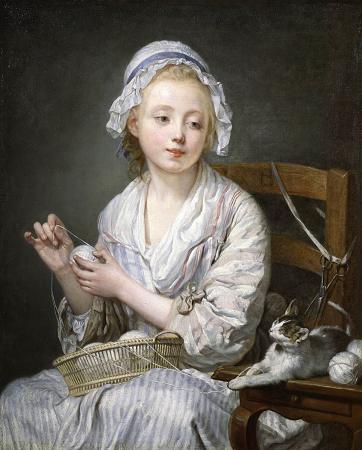Jean-Baptiste Greuze (1725 - 1805). Jean-Baptiste Greuze was a French painter of portraits, genre scenes, and history painting. Greuze was born at Tournus, a market town in Burgundy. He is generally said to have formed his own talent; at an early age his inclinations, though thwarted by his father, were encouraged by a Lyonnese artist named Grandon, or Grondom, who enjoyed during his lifetime considerable reputation as a portrait-painter. Grandon not only persuaded Greuze's father to give way to his son's wishes, and permit the boy to accompany him as his pupil to Lyon, but, when at a later date he-himself left Lyon for Paris, Grandon carried young Greuze with him. Settled in Paris, Greuze worked from the living model in the school of the Royal Academy, but did not attract the attention of his teachers; and when he produced his first picture, Le Père de famille expliquant la Bible a ses enfants, considerable doubt was felt and shown as to his share in its production. By other and more remarkable works of the same class Greuze soon established his claims beyond contest, and won the notice and support of the well-known connoisseur La Live de Jully, the brother-in-law of Madame d'Epinay. In 1755 Greuze exhibited his Aveugle trompé, upon which, presented by Pigalle the sculptor, he was immediately agréé by the Academy. Towards the close of the same year he left France for Italy, in company with the Abbé Louis Gougenot. Gougenot had some acquaintance with the arts, and was highly valued by the Academicians, who, during his journey with Greuze, elected him an honorary member of their body on account of his studies in mythology and allegory; his acquirements in these respects are said to have been largely utilized by them, but to Greuze they were of doubtful advantage, and he lost rather than gained by this visit to Italy in Gougenot's company. He had undertaken it probably in order to silence those who taxed him with ignorance of great models of style, but the Italian subjects which formed the entirety of his contributions to the Salon of 1757 showed that he had been put on a false track, and he speedily returned to the source of his first inspiration. In 1759, 1761 and 1763 Greuze exhibited with ever-increasing success; in 1765 he reached the zenith of his powers and reputation. In that year he was represented with at least thirteen works, amongst which may be cited La Jeune Fille qui pleure son oiseau mort, La Bonne Mère, Le Mauvais fils puni and La Malediction paternelle. The Academy took occasion to press Greuze for his diploma picture, the execution of which had been long delayed, and forbade him to exhibit on their walls until he had complied with their regulations. I have read the letter, said Diderot, which is a model of honesty and reverence; I have seen Greuze's response, which is a model of vanity and impertinence: he should have backed it up with a masterpiece, and that's precisely what he didn't do. Greuze wished to be received as a historical painter, and produced a work which he intended to vindicate his right to despise his qualifications as a genre artist. This unfortunate canvas was exhibited in 1769 side by side with Greuze's portrait of Jeaurat and his admirable Petite Fille au chien noir. The Academicians received their new member with all due honours, but at the close of the ceremonies the Director addressed Greuze in these words: Sir, the Academy has accepted you, but only as a genre painter; the Academy has respect for your former productions, which are excellent, but she has shut her eyes to this one, which is unworthy, both of her and of you yourself. Greuze, greatly incensed, quarrelled with his confreres, and ceased to exhibit until, in 1804, the Revolution had thrown open the doors of the Academy to all the world. In the following year, on 4 March 1805, he died in the Louvre in great poverty. He had been in receipt of considerable wealth, which he had dissipated by extravagance and bad management, so that during his closing years he was forced to solicit commissions which his enfeebled powers no longer enabled him to carry out with success. At the funeral of the long neglected old man, a young woman deeply veiled and overcome with emotion plainly visible through her veil, laid upon the coffin, just before its removal, a bouquet of immortelles and withdrew to her devotions. Around the stem was a paper inscribed: These flowers offered by the most grateful of his students are emblems of his glory. It was Mlle Mayer, later the friend of Prudhon. The brilliant reputation which Greuze acquired seems to have been due, not to his accomplishments as a painter-for his practice is evidently that current in his own day-but to the character of the subjects which he treated.
more...














